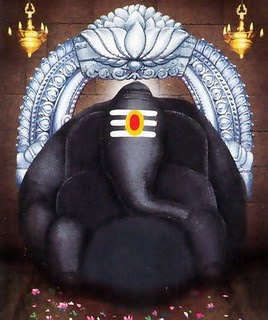Exploring the Legend of Kanipakam: Unraveling the Name and Origin:
Kanipakam, a name composed of "KANI," symbolizing an expanse of one and a quarter acres, and "PAKAM," denoting the flow of water for irrigation, encapsulates a captivating tale entrenched in ancient lore.
Amidst this surreal spectacle, their persistent endeavors yielded an extraordinary revelation—a Swayambhu idol of Swamy Vinayaka emerged. Overwhelmed with profound joy and reverence, the brothers, in humble devotion, offered fervent prayers, a profusion of coconuts, and performed Mangalahaarathi rituals to venerate the divine idol. This auspicious event marked the sacred declaration of the idol as Swayambhu—an entity self-manifested.
The divine blessings bestowed upon them echoed through the ceremonial offering of coconut water. These offerings cascaded through ingenious channels, traversing an area extending over one and a quarter acres—an event that etched the very essence of "KANIPAKAM" into existence.
Despite the passage of time shrouding the exact genesis of the temple in mystery, historical narratives speak of its existence dating back a thousand years. The enduring legacy of Kanipakam remains evident today, manifested in the perpetual flow of water encompassing the divine presence of Swamy. This incessant flow, particularly magnified during the monsoons, serves as an eternal testament to the temple's mythical origins and divine significance.
The Swayambhu idol at Kanipakam Temple bears a profound significance encapsulated within its very form. Evident upon the deity is a head wound, a relic from a time when an iron weapon struck it. This distinct mark stands as a testament to the idol's origin and mystique.
An intriguing facet unfolds as the Swayambhu idol exhibits a perpetual growth. Initially, during its discovery, only the head portion of the deity was visible. However, as time passed, the idol's manifestation extended, now revealing itself up to the abdomen—a tangible representation of the deity's continuous expansion.
To epitomize this perpetual growth, a silver "KAVACHAM" generously bestowed by Smt. Lakshmamma, wife of Bezawada Siddaiah from Aragonda's Gollapalli Village in 1947, now portrays an intriguing contrast. Once fitting and adorning the deity, this Kavacham now appears diminutive, no longer suitable to embellish the evolving idol.
Moreover, the water encompassing the deity within the well holds immense sanctity. It is revered as "PAVITHRA THEERTHAM," distributed among devotees—a sacred offering that embodies divine purity and blessings.
The temple's profound symbolism, reflected in the idol's growth and the sacredness of its surroundings, continues to intrigue and enthrall devotees, marking Kanipakam as a place of perpetual spiritual evolution and reverence.
Following the self-elevation of Lord Vinayaka Swamy at Kanipakam, two brothers, Sankudu and Likhithudu, embarked on a pilgrimage to behold the divine presence of Lord Swayambhu Sri Vinayaka. Their journey was arduous, and exhaustion plagued Likhitudu, the younger sibling. Hunger drove him to seek succor from a mango tree, despite warnings from Sankudu, who cautioned against plucking fruit belonging to the king. Ignoring the warning due to fatigue and thirst, Likhitudu consumed the forbidden fruit.
Regrettably, Sankudu reported the incident to the king, leading to a severe decree: the younger brother's hands were to be amputated for the theft. Grief-stricken by the consequences, Sankudu sought solace by immersing both himself and his brother in the river near the Swayambhu Vinayaka Temple, fervently praying for divine intervention. Astonishingly, their prayers were answered as Likhitudu's lost hands miraculously reappeared.
With immense gratitude, the brothers sought Darshan of Lord Vinayaka Swamy, offering heartfelt vows for their blessing. Inspired by this divine benevolence, they shared the tale of Swayambhu Sri Vinayaka's kindness with the neighboring villagers. Consequently, the river where Lord Vinayaka reinstated Likhithudu's hands was revered and henceforth named the "Bahuda River." This incredible event became a testament to the deity's compassion and the divine grace emanating from Kanipakam.
